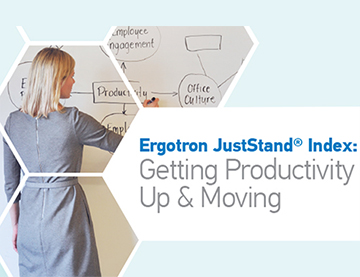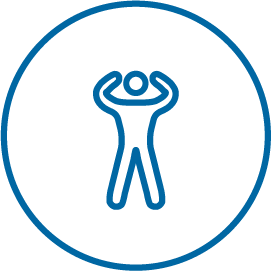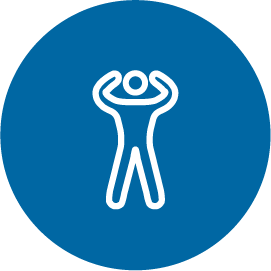THE FACTS
The human body is designed to move.
For thousands of years, that’s exactly what humans did. In the mid-20th century, however, rapid technological advances (think: cars, TVs, computers, etc.) began chipping away at physical activity, and as technology did more of the heavy lifting, people became increasingly sedentary.
Fast forward to today; here's where we are:

12 HOURS
the amount of time the average person is sitting (aka sedentary) a day

4th LEADING
risk factor for global mortality is physical inactivity

3.2 MILLION
deaths a year are related to physical inactivity
Whether it's time spent working (in the office, school or home), driving, eating or watching TV, the impacts our sedentary lifestyles, often referred to as "sitting disease," may be one of the most unanticipated health threats of our modern time.
Sitting Disease:
A term coined by the scientific community, commonly used when referring to metabolic syndrome and the ill-effects of an overly sedentary lifestyle.
Now that's the bad news. The good news is...
…by making simple lifestyle changes we can make big strides to lead healthier lives. Mounting medical research proves that if we choose to stand up, sit less and move more, we can experience a great number of attainable benefits to our health, our minds and our bodies
What You Need to Know

It’s a common misconception that exercise can compensate for too much sitting. Even if you engage in the doctor-recommended 150 minutes of moderate to vigorous activity per week, you are still subject to the negative impact of too much sitting.

Low intensity, ‘non-exercise’ activities like standing and walking are much more important than most realize. In fact, low level activities play a crucial metabolic role and account for more of our daily energy expenditure than moderate-to-high intensity activities.

Alternate between sitting and standing every 30 minutes for optimum health. Some of the research community (JustStand.org included!) are promoters of this sit-stand-switch philosophy.
JustStand® Index
While the impacts of sedentary lifestyles have been well-documented, little attention has been given to how prolonged sitting impacts the overall health of an organization. To explore this issue, Ergotron regularly commissions third-party research to understand full-time employees’ attitudes towards sitting at work and how they believe it impacts their productivity and overall wellbeing. The research also examines the business implications of sedentary lifestyles.
THE BENEFITS
There are a great number of attainable benefits to our health, our minds and our bodies, if we simply choose to stand up, sit less and move more.


SupportsBone Health
Bones, like muscles, require regular movement to maintain strength – low-level activity helps improve your bone health.
READ MORE

SupportsBone Health
Bones, like muscles, require regular movement to maintain strength – low-level activity helps improve your bone health.


EnhancesBrain Power
Standing delivers more oxygen and nutrients to the brain through improved blood flow.
READ MORE

EnhancesBrain Power
Standing delivers more oxygen and nutrients to the brain through improved blood flow.
50%
Those who maintain regular bouts of activity reduce risk of cognitive decline by 50%1

Physical activity enhances neurogenesis (the creation of new brain cells) in regions of the brain associated with critical thinking2

In the classroom
Studies show that movement strengthens learning and improves memory and retrieval3

In the office
Studies show movement is linked to improved concentration and greater productivity


BurnsCalories
When you're moving, fat-burning enzymes stay activated, burning far more calories than when you’re sitting. It can add up over time.
READ MORE

BurnsCalories
When you're moving, fat-burning enzymes stay activated, burning far more calories than when you’re sitting. It can add up over time.


Reduces risk ofCancer
Studies have linked prolonged sitting to a greater risk for colon, breast and endometrial cancers. Research has suggested that regular movement boosts natural antioxidants that kill cell-damaging - and potentially cancer-causing - free radicals.
READ MORE

Reduces risk ofCancer
Studies have linked prolonged sitting to a greater risk for colon, breast and endometrial cancers. Research has suggested that regular movement boosts natural antioxidants that kill cell-damaging - and potentially cancer-causing - free radicals.
1-2 minutes
1-2 minute breaks from sitting each hour is enough to lower risk factors of cancer1
40%
Those who are physically active have a 40% decrease in cancer mortality2
92k
92,000 cases of breast and colon cancer in the US each year are linked to a lack of physical activity1
65%
In women, sitting 6+ hours a day has been linked to a 65% greater risk of multiple myeloma3
21-25%
Physical activity is estimated to be responsible for 21-25% of breast and colon cancers4


Reduces risk ofCardiovascular Disease
Reducing sedentary time is linked to a lower risk of cardiovascular disease and death due to heart attack.
READ MORE

Reduces risk ofCardiovascular Disease
Reducing sedentary time is linked to a lower risk of cardiovascular disease and death due to heart attack.
45%
Those who are active have a 45% lower risk of developing cardiovascular disease1
64%
Men who report 23+ hours a week of sedentary activity (3 hours per day) have a greater risk of dying from cardiovascular disease2
8+ hours
Doubled risk of cardiovascular disease if you sit 8+ hours a day3
1/2 risk
1/2 risk of heart attack in women who are physically active 3+ hours per week4
30%
30% of ischemic heart disease cases are associated with sedentary lifestyles5
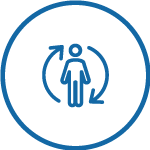
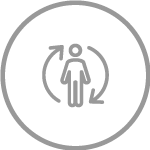
IncreasesCirculation
Blood circulation is crucial to good health, but sitting can impede blood flow, affecting every system of the body.
READ MORE

IncreasesCirculation
Blood circulation is crucial to good health, but sitting can impede blood flow, affecting every system of the body.


SupportsDiabetes
As the rate of those affected with Type 2 diabetes continues to increase, breaking up sedentary time can aid in managing insulin levels and reducing that risk, as there is a significant correlation between excessive sitting and diabetes.
READ MORE

SupportsDiabetes
As the rate of those affected with Type 2 diabetes continues to increase, breaking up sedentary time can aid in managing insulin levels and reducing that risk, as there is a significant correlation between excessive sitting and diabetes.


Reduces risk ofEarly Mortality
Research has found strong links between sedentary behavior and a variety of serious health problems, which increase the risk of early mortality.
READ MORE

Reduces risk ofEarly Mortality
Research has found strong links between sedentary behavior and a variety of serious health problems, which increase the risk of early mortality.
4th leading
Physical inactivity is the fourth-leading risk factor for death1
30%
Replacing 1 hour of sitting with low-level activity - like walking - can reduce mortality by 30%2
22 minutes
Every hour you sit, you can slash your life expectancy by nearly 22 minutes3
50%
Sitting for 4+ hours per day results in a 50% increased greater risk of death4
1.6 million
1.6 million deaths annually can be attributed to insufficient physical activity5


IncreasesEnergy
Standing is a simple but underrated remedy to increase alertness and receive a natural jolt of energy.
READ MORE

IncreasesEnergy
Standing is a simple but underrated remedy to increase alertness and receive a natural jolt of energy.


Increases ability toFocus & Productivity
Standing on the job promotes a greater mental awareness, which leads to far greater productivity and improved concentration. Low-level movement can also reduce pain and discomfort, allowing people to better focus.
READ MORE

Increases ability toFocus & Productivity
Standing on the job promotes a greater mental awareness, which leads to far greater productivity and improved concentration. Low-level movement can also reduce pain and discomfort, allowing people to better focus.


SupportsHeart Health
Subtle movement - even standing - breaks up prolonged sitting and promotes higher HDL (“good” cholesterol) and lower LDL (“bad cholesterol”) which in turn can improve blood pressure and lower the risk of heart attack.
READ MORE

SupportsHeart Health
Subtle movement - even standing - breaks up prolonged sitting and promotes higher HDL (“good” cholesterol) and lower LDL (“bad cholesterol”) which in turn can improve blood pressure and lower the risk of heart attack.

Muscles burn less fat and blood flows more slowly during prolonged sitting, which leads to clogged arteries and fatty liver disease
33%
After 3 hours of uninterrupted sitting, young girls experience 33% reduced vascular function1

Increases in sedentary behavior have been associated with increased blood pressure among children, teenagers and adults2
2 hours
Every 2 hours of sitting time replaced with standing saw 11% lower triglyceride levels and 6% lower total HDL-cholesterol ratio3


BoostsMetabolism
Alternating between sitting and standing increases the enzymes needed to metabolize food.
READ MORE

BoostsMetabolism
Alternating between sitting and standing increases the enzymes needed to metabolize food.


ImprovesMood State
Moving muscles pumps fresh blood and oxygen to the brain, which releases mood enhancing chemicals.
READ MORE

ImprovesMood State
Moving muscles pumps fresh blood and oxygen to the brain, which releases mood enhancing chemicals.
100%
Of workers reported positive effects on mood states after reducing sitting time2
7 weeks
Employees reported improved mood states after using a sit-stand desk for 7 weeks1

Incorporating movement has shown to enhance employee enthusiasm and job satisfaction2

Incorporating movement in the classroom has been shown to enhance learner motivation and morale3
6+ hours
Sitting for 6+ hours during the workday puts you at a higher risk for anxiety and depression4
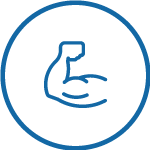

TonesMuscles
Standing enlists large muscle groups along with the vestibular system which controls balance. Unused, weak muscles leave your joints unstable and prone to injury and chronic pain.
READ MORE

TonesMuscles
Standing enlists large muscle groups along with the vestibular system which controls balance. Unused, weak muscles leave your joints unstable and prone to injury and chronic pain.

When standing, abdominal muscles are tensed and tightened, but when sitting, those muscles go unused, ultimately leading to a weak mid-section

Sitting makes hips very tight, which in turn, can affect posture, balance and make it harder to move freely
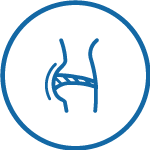
The glute muscles weaken from lack of use (referred to as dormant butt syndrome) and become soft and undefined from lack of use 1


Reduces risk ofOsteoporosis
People who are more active have a lower risk of osteoporosis than those who are more sedentary.
READ MORE

Reduces risk ofOsteoporosis
People who are more active have a lower risk of osteoporosis than those who are more sedentary.


Aids InPain Relief
Our bodies were made to stand, so maintaining the seated position is physically stressful. This, in turn, can cause body pain, herniated discs, damaged nerves, degenerated joints and dementia.
READ MORE

Aids InPain Relief
Our bodies were made to stand, so maintaining the seated position is physically stressful. This, in turn, can cause body pain, herniated discs, damaged nerves, degenerated joints and dementia.
54%
54% of workers reported reduced upper back and neck pain when sitting time was decreased1
78%
78% of workers with chronic low back pain reported a pain-free day2
#1 cause
Lower back pain is #1 cause of job related disability and a top risk factor for absenteeism3
$85 billion
Due to low back pain associated with sedentary behavior, $85 billion is lost a year in healthcare, lost income and productivity costs2


ImprovesPosture
Standing (with proper posture!) puts the spine into a more naturally aligned position.
READ MORE

ImprovesPosture
Standing (with proper posture!) puts the spine into a more naturally aligned position.

Craning your neck forward can strain the cervical vertebrae and lead to damage that is difficult to repair1
20 minutes
20 minutes is all it takes before bad posture and slouching deforms your ligaments2

The very act of sitting puts added pressure on your spine and compresses the disks that make up your back. So when the posture breaks down, it causes many spinal problems2


FightsSitting Disease
Standing more helps combat “Sitting Disease” - a term coined by the scientific community, it’s commonly used when referring to metabolic syndrome and the ill-effects of an overly sedentary lifestyle.
READ MORE

FightsSitting Disease
Standing more helps combat “Sitting Disease” - a term coined by the scientific community, it’s commonly used when referring to metabolic syndrome and the ill-effects of an overly sedentary lifestyle.
For a full list of references, click here.
THE RESEARCH
As society has grown more sedentary, the scientific research community has taken notice and conducted in-depth studies around the implications of prolonged sitting. This growing body of research has found a strong correlation between long periods of sitting and elevated risk of illness or injury. Browse the chart below to review the latest insights and findings around the impacts of sedentary behavior or see the research using Ergotron Sit-Stand Desks at research.ergotron.com.
| Title | Organization | Authors | Setting | Intervention | Date |
|---|---|---|---|---|---|
| A Cluster Randomized Controlled Trial to Reduce Office Workers’ Sitting Time: Effect on Activity Outcomes | International Journal of Behavioral Nutrition and Physical Activity | Brakenridge CL, Fjeldsoe BS, Young DC, Winkler EA, Dunstan DW, Straker LM, Healy GN | Office | Sit-stand workstation (WorkFit-S) | 2016 |
| Evaluating the effectiveness of organisational-level strategies with or without an activity tracker to reduce office workers' sitting time: a cluster-randomised trial. | International Journal of Behavioral Nutrition and Physical Activity | Brakenridge CL, Fjeldsoe BS, Young DC, Winkler EA, Dunstan DW, Straker LM, Healy GN | Office | Sit-stand workstation (WorkFit-S) | 2016 |
| Office workers' objectively assessed total and prolonged sitting time: Individual-level correlates and worksite variations | Preventative Medicine Reports | Nyssa T. Hadgraft, Genevieve N. Healy, Neville Owen, Elisabeth A.H. Winkler, Brigid M. Lynchaeg, Parneet Sethia, Elizabeth G. Eakin, Marj Moodieh, Anthony D. LaMontagneh, Glen Wiesnera, Lisa Willenberg, David W.Dunstan | Office | Sit-stand workstation (WorkFit-S) | 2016 |
| A Cluster RCT to Reduce Workers’ Sitting Time: Impact on Cardiometabolic Biomarkers | Medicine & Science in Sports & Exercise | HEALY, GENEVIEVE N.; WINKLER, ELISABETH A. H.; EAKIN, ELIZABETH G.; OWEN, NEVILLE; LAMONTAGNE, ANTHONY D.; MOODIE, MARJ; DUNSTAN, DAVID W. | Office | Sit-stand workstation (WorkFit-S) | 2017 |
| Cardiometabolic Impact of Changing Sitting, Standing, and Stepping in the Workplace | Medicine & Science in Sports & Exercise | ELISABETH A. H. WINKLER; SEBASTIEN CHASTIN; ELIZABETH G. EAKIN; NEVILLE OWEN; ANTHONY D. LAMONTAGNE; MARJ MOODIE; PADDY C. DEMPSEY; BRONWYN A. KINGWELL; DAVID W. DUNSTAN; GENEVIEVE N. HEALY | Office | Sit-stand workstation (WorkFit-S) | 2018 |
| Economic evaluation of a randomized controlled trial of an intervention to reduce office workers’ sitting time: the "Stand Up Victoria" trial | Scandinavian Journal of Work, Environment & Health | Gao L, Flego A, Dunstan DW, Winkler EAH, Healy GN, Eakin EG, Willenberg L, Owen N, LaMontagne AD, Lal A, Wiesner GH, Hadgraft NT, Moodie ML | Office | Sit-stand workstation (WorkFit-S) | 2018 |
| “Could you sit down please?” A qualitative analysis of employees' experiences of standing in normally-seated workplace meetings | PLOS ONE | Louise Mansfield, Jennifer Hall, Lee Smith, Molly Rasch, Emily Reeves, Stephen Dewitt, Benjamin Gardner | Office; Adults who stand during meetings | Participants were interviewed about physical and emotional effects of standing during meetings. | 2018 |
| Gender and posture are significant risk factors to musculoskeletal symptoms during touchscreen tablet computer use | J. Phys. Ther. Sci. 30: 855–861, 2018 | Szu-Ping Lee, PT, PhD, Ya-Ting Hsu, PT, PhD1, Betina Bair, PT, DPT, Marissa Toberman, PT, DPT, Lung-Chang Chien, DrPH | MSD factors related to Touchscreen Tablets in university students, administrators, and faculty | The online questionnaire was composed of 22 items in 3 categories: 1) demographic information, 2) typical device usage behavior, and 3) current neck and shoulder symptoms and symptoms during use which include duration, types, severity, and location of symptoms | 2018 |
| Physical activity and the risk of cancer (dietandcancerreport.org) | Continuous Update Project (CUP), Third Expert Report 2018 | World Cancer Research Fund/American Institute for Cancer Research | Adult Cancer Risk | Research Review | 2018 |
| Why Are Children Different in Their Daily Sedentariness? | PLOS ONE | Thayse Natacha Gomes, Donald Hedeker, Fernanda Karina dos Santos, Sara Pereira, Peter T. Katzmarzyk, José A. R. Maia | Classroom | Actigraph GT3X+ accelerometers (ActiGraph,Pensacola, FL) were used to monitor sedentary time. | 2015 |
| Sedentary behavior associated with reduced medial temporal lobe thickness in middle-aged and older adults | PLOS ONE | Siddarth P, Burggren AC, Eyre HA, Small GW, Merrill DA | Middle-aged to Older Adults | Time spent sitting assessment and MRI | 2018 |
| Stand-Biased Versus Seated Classrooms and Childhood Obesity: A Randomized Experiment in Texas | American Journal of Public Health | Wendel ML, Benden ME, Zhao H, and Jeffrey C | Classroom | Standing desks | 2016 |
| Prevalence of childhood and adult obesity in the United States, 2011-2012 | Journal of the American Medical Association | Ogden CL, Carroll MD, Kit BK, and Flegal KM | Non-specific | N/A | 2014 |
| The association between school-based physical activity, including physical education, and academic performance | Centers for Disease Control and Prevention | N/A | Classroom | School based activity | 2010 |
| Economic impact of moderate‐vigorous physical activity among those with and without established cardiovascular disease: 2012 medical expenditure panel survey | Journal of the American Heart Association | Valero‐Elizondo J, Salami JA, Osondu CU, Ogunmoroti O, Arrieta A, Spatz ES, Younus A, Rana JS, Virani SS, Blankstein R, Blaha MJ, Veledar E, Nasir K | Non-specific | Moderate and vigorous activity | 2016 |
| Effect of frequent interruptions of prolonged sitting on self-perceived levels of energy, mood, food cravings and cognitive function | International Journal of Behavioral Nutrition and Physical Activity | Bergouignan A, Legget KT, Jong ND, Kealey E, Nikolovski J, Groppel JL, Jordan C, O’Day R, Hill JO, and Bessesen DH | Non-specific | Moderate activity | 2016 |
| Causes of death associated with prolonged TV viewing | American Journal of Preventive Medicine | Keadle SK PhD, Moore SC, PhD, Sampson JN, PhD, Xiao Q, PhD, Albanes D, MD, and Matthews CE, PhD | Home | N/A | 2015 |
| Causal assessment of occupational standing or walking and low back pain: results of a systematic review | The Spine Journal | Roffey DM, Wai EK, Bishop P, and Kwon BK, and Dagenais S | Office | N/A | 2010 |
| Breaking up workplace sitting time with intermittent standing bouts improves fatigue and musculoskeletal discomfort in overweight/obese office workers | Occupational and Environmental Medicine | Thorp AA, Kingwell BA, Owen N, and Dunstan DW | Office | Sit-stand desks | 2014 |
| Running increases cell proliferation and neurogenesis in the adult mouse dentate gyrus | Nature Neuroscience | van Praag H, Kempermann G, and Gage F H | Non-specific | N/A | 1999 |
| Exercise physiology versus inactivity physiology: an essential concept for understanding lipoprotein lipase regulation | Exercise and Sport Sciences Reviews | Hamilton MT, Hamilton DG, and Zderic TW | Non-specific | N/A | 2004 |
| Mortality and burden of disease attributable to selected major risks | World Health Organization | Mathers C, Stevens G, and Mascarenhas M | Non-specific | N/A | 2009 |
| Increased cardiometabolic risk is associated with increased TV viewing time | Journal of the American College of Sports Medicine | Wijndaele K, Healy GN, Dunstan DW, Barnett AG, Salmon J, Shaw JE, Zimmet PZ, and Owen N | Home | N/A | 2010 |
| Physical exercise and executive functions in preadolescent children, adolescents and young adults: a meta-analysis | British Journal of Sports Medicine | Verburgh L, Konigs M, Scherder E J A, and Oosterlaan J | Office | Sit-stand desks | 2012 |
| Television viewing time and reduced life expectancy: a life table analysis | British Journal of Sports Medicine | Veerman JK, Healy GN, Cobiac LJ, VosT, Winkler EAH, Owen N, and Dunstan DW | Home | N/A | 2012 |
| The frequency of osteogenic activities and the pattern of intermittence between periods of physical activity and sedentary behaviour affects bone mineral content: the cross-sectional NHANES study | BMC Public Health | Chastin SFM, Mandrichenko O, and Skelton DA | Non-specific | N/A | 2014 |
| Replacing sitting time with standing or stepping: associations with cardio-metabolic risk biomarkers | European Heart Journal | Healy GN, Winkler EA, Owen N, Anuradha S, and Dunstan DW | Non-specific | N/A | 2015 |
| Impact of prolonged sitting on vascular function in young girls | Experimental Psychology | McManus AM, Ainslie PN, Green DJ, Simair RG, Smith K, and Lewis N | Non-specific | Moderate activity | 2015 |
| Effects of interrupting children's sedentary behaviors with activity on metabolic function: a randomized trial | Journal of Clinical Endocrinology & Metabolism | Belcher BR, Berrigan D, Papachristopoulou A, Brady SM, Bernstein SB, Brychta RJ, Hattenbach JD, Tigner IL, Courville AB, Drinkard BE, Smith KP, Rosing DR, Wolters PL, Chen KY, and Yanovski JA | Non-specific | Walking | 2015 |
| Mortality benefits for replacing sitting time with different physical activities | Medicine & Science in Sports & Exercise | Matthews CE, Moore SC, Sampson J, Blair A, Xiao Q, Keadle SK, Hollenbeck A, and Park Y | Non-specific | N/A | 2015 |
| Watching television and risk of mortality from pulmonary embolism among Japanese men and women | Circulation | Shirakawa T, Iso H, Yamagishi K, Yatsuya H, Tanabe N, Ikehara S, Ukawa S, and Tamakoshi A | Non-specific | N/A | 2016 |
| Sedentary lifestyle and state variation in coronary heart disease mortality | Public Health Reports | K K Yeager, R F Anda, C A Macera, R S Donehoo, and E D Eaker | Non-specific | N/A | 1995 |
| Appraisal of risk factors for stroke in Nigerian Africans - a prospective case - control study | African Journal of Neurological Sciences | Amu E, Ogunrin O, and Danesi M | Non-specific | N/A | 2005 |
| Role of low energy expenditure and sitting in obesity, metabolic syndrome, type 2 diabetes, and cardiovascular disease | American Diabetes Association | Hamilton MT, Hamilton DG and Zderic TW | Non-specific | N/A | 2007 |
| Amount of time spent in sedentary behaviors in the United States, 2003–2004 | American Journal of Epidemiology | Matthews CE, Chen KY, Freedson PS, Buchowski MJ, Beech BM, Pate RR, and Troiano RP | Non-specific | Activity monitor | 2008 |
| Sedentary behaviors increase risk of cardiovascular disease mortality in men | Medicine & Science in Sports & Exercise | Warren TY, Barry V, Hooker SP, Sui X, Church TS, and Blair SN | Home | N/A | 2010 |
| Television viewing time and mortality | Circulation | Dunstan DW, Barr ELM, Healy GN, Salmon J, Shaw JE, Balkau B, Magliano DJ, Cameron AJ, Zimmet PZ, and Owen N | Home | N/A | 2010 |
| Health risks, correlates, and interventions to reduce sedentary behavior in young people | American Journal of Preventive Medicine | Salmon J, Tremblay MS, Marshall SJ, and Hume C | Home | N/A | 2011 |
| Long-term sedentary work and the risk of subsite-specific colorectal cancer | American Journal of Epidemiology | Boyle T, Fritschi L, Heyworth J, and Bull F | Non-specific | N/A | 2011 |
| Television viewing and risk of type 2 diabetes, cardiovascular disease, and all-cause mortality | The JAMA Network | Anders G, MPH, MSc; Frank B. and Hu, MD, PhD | Home | N/A | 2011 |
| Association of sedentary behaviour with metabolic syndrome: a meta-analysis | PLOS One | Edwardson CL, Gorely T, Davies MJ, Gray LJ, Khunti K, Wilmot KG, Yates T, and Biddle SJH | Non-specific | N/A | 2012 |
| Too little exercise and too much sitting: inactivity physiology and the need for new recommendations on sedentary behavior | Current Cardiovascular Risk Reports | Hamilton MT, Healy GN, Dunstan DW, Zderic TW, Owen N | Non-specific | N/A | 2008 |
| Deleterious associations of sitting time and television viewing time with cardiometabolic risk biomarkers | American Diabetes Association | Thorp AA, Owen N, Healy GN, Clark BK, Salmon J, Ball K, Shaw JE, Zimmet PZ, Dunstan DW | Home | N/A | 2009 |
| Prolonged sedentary time and physical activity in workplace and non-work contexts: a cross-sectional study of office, customer service and call centre employees | International Journal of Behavioral Nutrition and Physical Activity | Thorp AA, Owen N, Healy GN, Winkler EA, Gardiner PA, Clark BK, Dunstan DW | Office | Accelerometer | 2010 |
| Reducing office workers’ sitting time: rationale and study design for the Stand Up Victoria cluster randomized trial | BMC Public Health | Gardiner PA, Healy GN, Robinson C, Winkler EA, Clark BK, Eakin EG, Owen N, Dunstan DW | Office | Training | 2013 |
| Leisure time spent sitting in relation to total mortality in a prospective cohort of US adults | American Journal of Epidemiology | Patel AV, Bernstein L, Deka A, Spencer Feigelson H, Campbell PT, Gapstur SM, Colditz GA, Thun MJ | Home | N/A | 2010 |
| Reducing occupational sitting time and improving worker health | Centers for Disease Control & Prevention | Pronk NP, Katz AS, Lowry M, Payfer JR | Office | Sit-stand desks (WorkFit) | 2011 |
| Impact of stand-biased desks in classrooms on calorie expenditure in children | American Journal of Public Health | Benden ME, Blake JJ, Wendel ML, Huber JC | Classroom | Sit-stand desks | 2011 |
| Patterns of objectively measured prolonged sedentary time and physical activity at work | International Journal of Behavioral Nutrition and Physical Activity | Thorp AA, Healy GN, Clark BK, Gardiner PA, Winkler EA, Owen N, Dunstan DW | Office | Accelerometer | 2012 |
| Sit-stand workstations: a pilot intervention to reduce office sitting time | American Journal of Preventative Medicine | Alkihajah TA, Reeves MM, Eakin EG, Winkler EA, Owen N, Healy GN | Office | Sit-stand desks (WorkFit) | 2012 |
| Using stand/sit workstations in classrooms: lessons learned from a pilot study | Journal of Public Health Management & Practice | Blake JJ, Benden ME, Wendel ML | Classroom | Sit-stand desks | 2012 |
| Minimal intensity physical activity improves insulin action and plasma lipids more than shorter periods of exercise in sedentary subjects | PLOS one | Duvivier B, Schaper NC, Bremers MA, van Crombrugge G, Menheere P, Kars M, Savelberg H | Non-specific | Activity schedule | 2013 |
| Reducing sitting time in office workers: short-term efficacy of a multicomponent intervention | Preventative Medicine | Healy GN, Eakin EG, Lamontagne AD, Owen N, EA Winkler, Wiesner G, Gunning L, Neuhaus M, Lawler S, Fjeldsoe BS, Dunstan DW | Office | Sit-stand desks (WorkFit) | 2013 |
| Standing-based office work shows encouraging signs of attenuating post-prandial glycaemic excursion | Occupational & Environmental Medicine | Buckley J, Morris M, Mellor D, Joseph F | Office | Sit-stand desks (WorkFit) | 2013 |
| Effects of a non-sedentary workspace on information elaboration and group performance | SAGE Journals | Knight AP, Baer M | Classroom | Chairs removed | 2014 |
| Workplace sitting and height-adjustable workstations, a randomized controlled trial | American Journal of Preventive Medicine | Neuhaus M, Healy GN, Dunstan DW, Owen N, Eakin EG | Office | Sit-stand desks (WorkFit) | 2014 |
| Iterative development of stand up Australia: multi-component intervention to reduce workplace sitting | Journal of Behavioral Nutrition & Physical Activity | Neuhaus M, Healy GN, Fjeldsoe BS, Lawler S, Owen N, Dunstan DW, LaMontagne AD, Eakin EG | Office | Sit-stand desks (WorkFit), training | 2014 |
| Avoiding sedentary behavior might lengthen telomeres: secondary outcomes from physical activity in older people | British Journal of Sports Medicine | Sjögren P, Fisher R, Kallings L, Svenson U, Roos G, Hellénius ML | Non-specific | Activity schedule | 2014 |
| Using sit-stand workstations to decrease sedentary time in office workers | Int’l Journal of Environmental Research & Public Health | Dutta N, Koepp GA, Stovitz SD, Levine JA, Pereira MA | Office | Sit-stand desks (WorkFit) | 2014 |
| Impact of a stand-biased desk on energy expenditure and physical activity for elementary students | Int’l Journal of Environmental Research & Public Health | Benden ME, Zhao H, Jeffrey CE, Wendel ML, Blake JJ | Classroom | Standing desks | 2014 |
| Sit, stand, learn: using workplace wellness sit-stand results to improve student behavior and learning | American College of Sports Medicine: Health & Fitness Journal | Katz A, Mulder B, Pronk N | Classroom | Sit-stand desks (WorkFit) | 2015 |
| Patterns and sustainability of sit-stand workstation use in a typical office workplace | International Society of Behavioural Nutrition and Physical Activity | Mair JL, Nugent C, Cleland I, Schmitz C, Murphy MH | Office | Sit-stand desks (WorkFit) | 2015 |
| Reducing children’s classroom sitting time using sit-to-stand desks | Oxford Journal of Public Health | Clemes SA, Barber SE, Bingham DD, Ridgers ND, Fletcher E, Pearson N, Salmon J, Dunstan DW | Classroom | Sit-stand desks (WorkFit) | 2015 |
| Standing up for learning: pilot investigation on neurocognitive benefits of stand-biased desks | International Journal of Environmental Research Public Health | Mehta RK, Shortz AE, Benden ME | Classroom | Standing desks | 2015 |
| Impact of a sit-stand workstation on chronic low back pain | Journal of Occupational & Environmental Medicine | Ognibene GT, Torres W, von Eyben R, Horst KC | Office | Sit-stand desks (WorkFit) | 2016 |
| Classroom standing desks & sedentary behavior: a systematic review | American Academy of Pediatrics | Minges KE, Chao AM, Irwin ML, Owen N, Park C, Whittemore R, Salmo J | Classroom | Standing desks | 2016 |
| Associations of total amount and patterns of sedentary behaviour with diabetes and metabolic syndrome: The Maastricht Study | Diabetologia | Garret G, Benden M, Mehta P, Pickens A, Peres C, Zhao H | Non-specific | Accelerometer | 2016 |
| Call center productivity over 6 months following a standing desk intervention | IIE Transactions on Occupational Ergonomics and Human Factors | Garret G, Benden M, Mehta P, Pickens A, Peres C, Zhao H | Office | Standing desks | 2016 |
